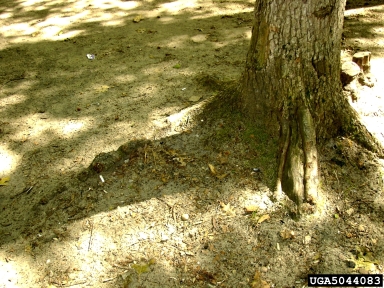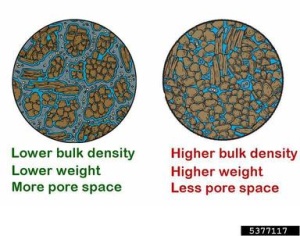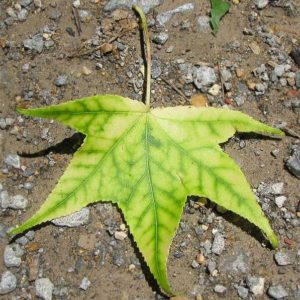Soil is one of the most important but most commonly overlooked component when it comes to the health and maintenance of a tree or shrub. Overtime soil issues can cause an overall drop in your tree’s health, increased susceptibility to pests, early leaf drop, and discoloration of leaves. Unfortunately, with summer’s heat, storms, and increased use of yards often comes soil issues for trees and shrubs. Read on to learn about the 4 most common soil issues that occur in late summer and how to treat them.
1. Too Little Moisture

By this time of summer, the hot days have taken its toll on the trees and the soil causing the many soils to have too little moisture. Too little moisture in the soil can cause your tree/shrub to experience drought stress. Drought stress can cause an overall drop in your tree’s health and make the tree more susceptible to insects and diseases. Signs of drought stress include wilting leaves, yellowing/browning of leaves, and early leaf drop. Too little moisture can also contribute to soil compaction as well which we will talk about later on in this article.
How To Treat: If your soil is too dry, make sure you are watering deeply and thoroughly 1 to 2 times a week. Take your cues from your tree’s soil. You want it to be moist but not soaking. You should NOT be able to make a mud ball out of the soil. It’s also okay for some portions of the soil to be wet and some to be dry. Instead of using a sprinkler try turning your hose to a dribble and leaving it in the critical root zone for 2-3 hours. Every couple of hours move the hose to a different location. This will give you a deeper and more thorough watering than if you were to turn the hose on full blast and drench the soil for 10 minutes. Learn More About Proper Watering
2. Mulch & Top Soil Erosion

July and August tend to bring lots of thunderstorms which can be great for dry soils but not so great for your mulch and topsoil. Heavy rains often wash away the mulch around your tree and the nutrient-rich topsoil over time leaving the remaining soil with a lack of nutrients and unprotected from the summer heat. This issue is easy for homeowners to spot. Check to see if your mulched areas are the correct depth (2-3inches), look for bare spots where mulch should be, and keep an eye out for newly exposed roots.
How To Treat: Luckily this soil issue is the easiest to fix on this list. Simply purchase and add back topsoil and mulch where they have been washed away from heavy storms. Be sure to follow our mulching tips and avoid common mulching mistakes for the best results.
3. Soil Compaction

In most urban and suburban areas the soils are very compacted especially after hot summers and in areas where there has been lots of foot traffic, like yards. When soil is compacted it causes a lack of pore space. Lack of pore space makes it impossible for enough water, oxygen, and nutrients to reach the tree’s roots. This can create problems for root growth and the health of the tree overall. Signs of soil compaction include areas under the canopy where the grass doesn’t grow, pooling or puddling of water in low areas, water running right off the soil in high areas, and areas where it’s hard to insert anything into the soil (a shovel or pole for example).
How To Treat: Aeration can fix compacted soils and prevent compaction in the future. Aeration uses high-velocity air tools and techniques to properly aerate the tree’s critical root zone (CRZ) loosening the soil. This creates macro and micropore space, making room for root growth.
4. Nutrient Deficiencies

Nutrient deficiencies often show up towards late summer and can severely stunt your plant’s growth and health. Trees are living organisms and require nutrients to grow and survive. Trees in the forest have an abundance of nutrients because of the delicate forest environment that has evolved. The trees in our yards; however, are a whole other story. Urban and suburban soils are often depleted of the proper nutrients especially after a long hot summer. Signs of nutrient deficiencies include yellowing leaves, stunted growth, and an overall decline in health.
How To Treat: Nutrient deficiencies are often treated through bio-stimulants. This mixture contains a natural blend of sugars, bacteria, humic acid, sea kelp extract, and fungi. This mix is great for soil management because it naturally fertilizes the tree without throwing off the soil balance. By introducing this blend to the critical root zone it will re-establish good soil composition and act as a multi-vitamin for your tree.
If your tree is suffering from nutrient deficiencies and soil compaction our arborists may recommend Vertical Mulching.
Vertical Mulching: This process is similar to de-compaction but goes one step further. Vertical mulching uses the same high-velocity air tool as de-compaction but the technician creates holes every 2 to 3 inches in the critical root zone. These holes are then filled with organic matter which permeates improving the overall composition.
It’s common that soils will have a combination of issues that feed off of each other. Often our Certified Arborists will utilize a combination of soil management treatments to get your soil back to a healthy state. If you think your soil may be having issues, give us a call at 703-573-3029 to schedule an appointment or book one through our online booking system. Our Certified Arborist will work with you to diagnose and treat your soil issues.


